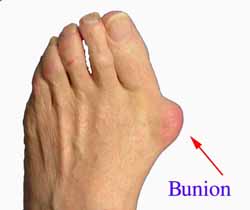How To Get Rid Of Bunions At Home
Overview
 A bunion is an enlargement of the joint at the base of the big toe (the metatarsophalangeal or MTP joint) that forms when the bone or tissue moves out of place. The toe bends inward at an awkward angle, which usually creates a large bone lump. If not treated, bunions can become very painful since this area supports a lot of body weight. The MTP joint can also become sore and stiff. Bunions can occur on the outside of the little toe as well.
A bunion is an enlargement of the joint at the base of the big toe (the metatarsophalangeal or MTP joint) that forms when the bone or tissue moves out of place. The toe bends inward at an awkward angle, which usually creates a large bone lump. If not treated, bunions can become very painful since this area supports a lot of body weight. The MTP joint can also become sore and stiff. Bunions can occur on the outside of the little toe as well.
Causes
The causes of bunions are "multifactorial". In other words generally many things contribute to their occurence. Shoewear per se is a contributory factor but it isn't possible to say that the type of shoewear is necessairily relevant. Often there is a hereditary component with other family members also suffering with the same condition.
Symptoms
Symptoms, which occur at the site of the bunion, may include pain or soreness, inflammation and redness, a burning sensation, possible numbness. Symptoms occur most often when wearing shoes that crowd the toes, such as shoes with a tight toe box or high heels. This may explain why women are more likely to have symptoms than men. In addition, spending long periods of time on your feet can aggravate the symptoms of bunions.
Diagnosis
A thorough medical history and physical exam by a physician is necessary for the proper diagnosis of bunions and other foot conditions. X-rays can help confirm the diagnosis by showing the bone displacement, joint swelling, and, in some cases, the overgrowth of bone that characterizes bunions. Doctors also will consider the possibility that the joint pain is caused by or complicated by Arthritis, which causes destruction of the cartilage of the joint. Gout, which causes the accumulation of uric acid crystals in the joint. Tiny fractures of a bone in the foot or stress fractures. Infection. Your doctor may order additional tests to rule out these possibilities.
Non Surgical Treatment
Bunions often respond to conservative care measures and should always be treated by a qualified healthcare professional in a timely and appropriate manner. Conservative treatment for bunions usually involves the following, splinting your great toe (so that it does not migrate toward the inside edge of your foot). A toe-spacer (such as Correct Toes) may be a useful tool, because it helps progressively splay and re-align all of your toes. Performing range of motion exercises (to move your big toe into a more favorable position). Supporting of the joints in the back of your foot that cause forefoot instability. Using shoes that allow the bunion splint to keep your big toe pointing straight ahead. 
Surgical Treatment
If nonsurgical treatment fails, you may want to consider surgery. Many studies have found that 85 to 90 percent of patients who undergo bunion surgery are satisfied with the results. Reasons that you may benefit from bunion surgery commonly include severe foot pain that limits your everyday activities, including walking and wearing reasonable shoes. You may find it hard to walk more than a few blocks (even in athletic shoes) without significant pain. Chronic big toe inflammation and swelling that doesn't improve with rest or medications. Toe deformity-a drifting in of your big toe toward the small toes. Toe stiffness-inability to bend and straighten your toe. Failure to obtain pain relief from nonsteroidal anti-inflammatory drugs. Their effectiveness in controlling toe pain varies greatly from person to person. Failure to substantially improve with other treatments such as a change in shoes and anti-inflammatory medication. As you explore bunion surgery, be aware that so-called "simple" or "minimal" surgical procedures are often inadequate "quick fixes" that can do more harm than good. And beware of unrealistic claims that surgery can give you a "perfect" foot. The goal of surgery is to relieve as much pain, and correct as much deformity as is realistically possible. It is not meant to be cosmetic.
Prevention
The simplest way to reduce your chance of developing foot bunion or bunionette problems is to wear good-fitting shoes. Avoid high heels as they push your feet forwards to the front of the shoe where they get squashed. Also avoid narrow fitting shoes, especially those that are pointed at the front with a narrow toe box as again, these place pressure through the toes pushing them inwards. Shoes should be comfortable and leave enough room for you to wiggle your toes. Remember, bunions rarely affect non-shoe wearing people. Exercising your feet can also help. By strengthening the foot muscles you can improve your foot position which can help reduce foot bunion problems. Simple exercises like picking up small objects with your toes can help.